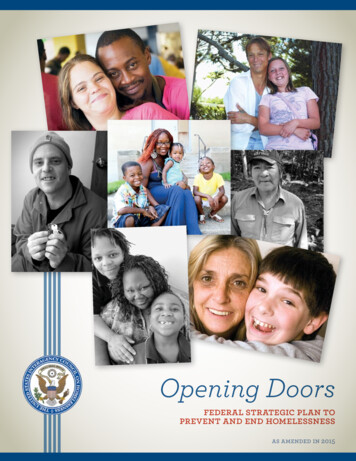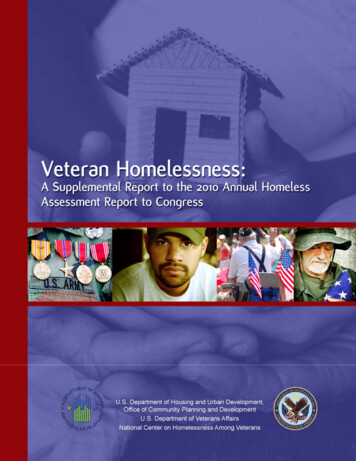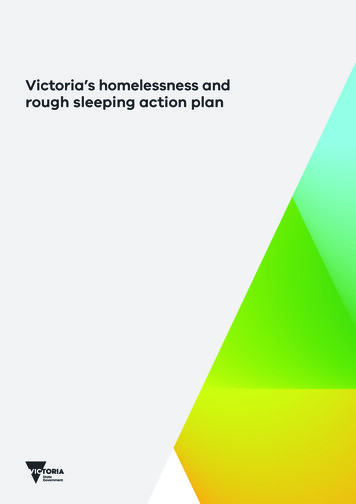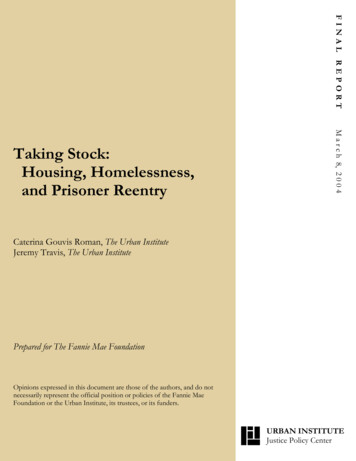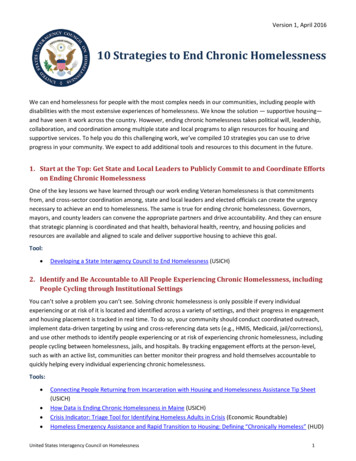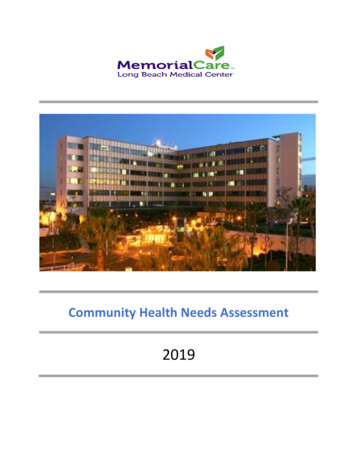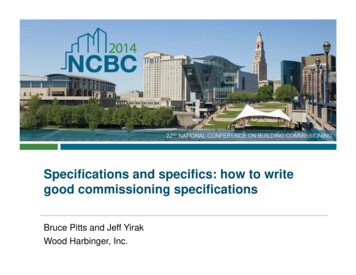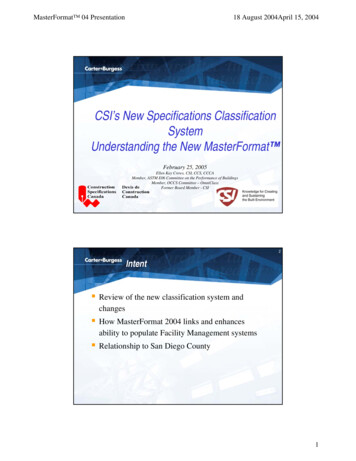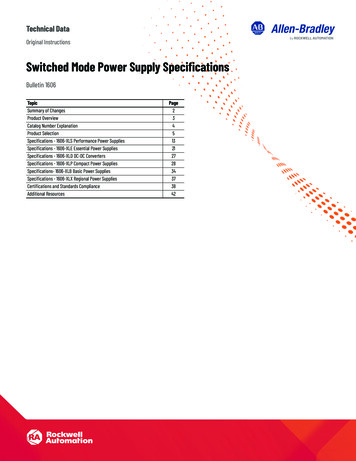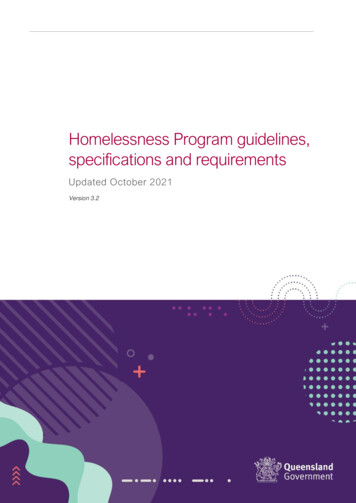
Transcription
Homelessness Program guidelines,specifications and requirementsUpdated October 2021Version 3.2
Table of Contents1Introduction . 42Context . 43About the Homelessness Program . 43.1Program aim . 43.2Underpinning approaches to service delivery . 43.2.1Housing first . 43.2.2Duration of need . 53.3Program logic . 63.4Service delivery framework . 73.4.13.54Service categories, types and sub-types . 7Service user groups . 133.5.1Broad service user groups . 133.5.2Service user groups . 143.5.3Service User Sub-Groups . 153.6Geographic Catchment . 153.7Service Deliverables . 163.7.1Outcomes and Targets . 163.7.2Outputs and Targets . 17Service delivery requirements . 214.1Requirements for all Access, Support, and Supported Accommodation and Housing. 224.1.1Case management . 224.1.2Accessibility . 224.1.3Client practice. 234.24.2.14.3Requirements for specific service categories . 23Access services (ST1 – 3) . 23Requirements for specific service types . 244.3.1Outreach Access (ST2) . 244.3.2Centre Based (ST1 and ST4) . 244.3.3Temporary Supported Accommodation (ST6, ST7 and ST8) . 244.4Requirements for Service Sub-Types . 254.4.1Immediate Supported Accommodation (ST7) . 254.4.2Transitional Supported Accommodation (ST8) . 254.5Requirements for Service User Groups . 254.5.1Young people . 254.5.2Women and children experiencing domestic and family violence . 264.5.3Aboriginal and Torres Strait Islander women and children in remote communities . 274.6Reporting requirements . 274.6.1Data collection and evaluation . 274.6.2Performance reporting . 28Homelessness Program Guidelines,Specifications and Requirements2
4.75Other requirements . 314.7.1Queensland Homelessness Information Platform . 314.7.2Human Services Quality Framework. 314.7.3Brokerage . 324.7.4Self-funded Domestic and Family Violence Refuges . 32Contact Information. 32Appendix 1: Glossary of Terms . 33Appendix 2: Counting Rules for Performance Measures . 36Appendix 3: Brokerage Report . 44Appendix 4: Guide to Writing Case Studies . 45Homelessness Program Guidelines,Specifications and Requirements3
1 IntroductionThe purpose of the Homelessness Program guidelines, specifications and requirements (theGuidelines) is to provide departmental staff and funded service providers with information regardingthe aims and purpose of the Homelessness Program and its operational requirements andexpectations.The Guidelines support improvements to the homelessness service system by providing clear andconsistent information about the aims of funding provided under the Homelessness Program and theprinciples and elements that must underpin service delivery for people who are homeless or at risk ofhomelessness. The content reflects contemporary service delivery based on the available evidence.This document was updated in October 2021 to reflect approved changes to: requirements relating to outcomes and output targets, and increase flexibility in relation to operating hours and catchment areas.Minor edits have also been made throughout the document to provide greater clarity of existingguidelines, specifications, and requirements for homelessness funding.2 ContextFunding is provided by both the Queensland and Commonwealth Governments through the NationalHousing and Homelessness Agreement (NHHA).3 About the Homelessness Program3.1 Program aimThe Homelessness Program aims to reduce the number of people who are homeless or at risk ofbecoming homeless in Queensland by funding services that assist people to: Obtain housing. Maintain their housing. Maximise their capacity to be independent, self-reliant and connected to appropriate social andcommunity supports.3.2 Underpinning approaches to service deliveryIt is expected that the delivery of Specialist Homelessness Services (SHS) funded under theHomelessness Program will be underpinned by the following approaches: Housing first. Duration of need.3.2.1 Housing firstA housing first approach transitions a person or household, wherever possible, straight fromhomelessness into stable, sustainable housing, with support provided where necessary to sustain thetenancy. This approach minimises vulnerable people having to be moved through multiple short-term,temporary living situations which can be unsettling and prevent their stabilisation.Many housing first initiatives target rough sleepers and/or people experiencing chronic homelessness,but the principles of housing first can be incorporated into other parts of the service continuum withdifferent target groups.Homelessness Program Guidelines,Specifications and Requirements4
These principles include: Accessing housing as quickly as possible, with ongoing support provided (where needed) toestablish and consolidate the new tenancy. Minimising moves between multiple short-term accommodation arrangements. Providing tenancy sustainment support to keep people housed. Working with other service providers to deliver coordinated services once housed. Connecting clients with mainstream services to provide ongoing support directed at helping themto sustain their tenancy. Facilitating connections to local community and social supports to build community connectednessand reduce social isolation.There are some people who have an ongoing need for personal and social support that cannot bemet by a homelessness service. It is essential that homelessness services connect people with theappropriate long-term support through mainstream and allied services such as mental health ordisability services and community facilities like neighbourhood centres.3.2.2 Duration of needA duration of need approach means providing accommodation and/or support for as long as the clientrequires to obtain and maintain sustainable housing. It is based on a person’s assessed need ratherthan an arbitrary time limit.Ongoing assessment determines a client’s changing needs and once housed, clients should beconnected with mainstream services to provide ongoing support directed at helping them to sustaintheir tenancy.The principles supporting a duration of need approach include: Clients stay in supported accommodation for as shorter time as possible, with transition to longerterm housing as the goal (in line with a housing first approach). A focus on addressing clients’ needs in the context of case management and doing ‘whatever ittakes’ to access housing. Regular and ongoing assessment of need. Supporting clients to find, establish and be able to sustain independent housing. Ensuring that clients have the community, social and agency support needed to sustain them inindependent housing. Encouraging clients to be self-reliant by providing them with the skills necessary to obtain theservices they require and to avoid ongoing dependency on homelessness services.Homelessness Program Guidelines,Specifications and Requirements5
3.3 Program logicThe diagram shows that the Homelessness Program Funding is an input for services provided toassist people (service users) who are homeless or at imminent risk of homelessness and people whohoused but at risk of homelessness, or to assist the Specialist Homelessness Service sector. Fundingis provided under four service categories:Service categoriesAccessSupportSupported accommodation andhousingService system support anddevelopmentService types and sub typesCentre-based accessOutreach accessVirtual accessCentre-based supportMobile supportTemporarySupported accommodation – immediate and transitionalSupported housing – onsite and off-siteService support and developmentCoordination/network developmentIn the short term: clients access appropriate services clients receive services they need clients access independent housing clients maintain independent housing clients have increased access to income, greater self-reliance and community connections Specialist homelessness sector is more efficient and effective Specialist homelessness sector is better coordinated and integrated.In the long term, the number of people who are homeless is reduced.Assumptions Assisting people to address the issues that put them at risk of homelessness will result in fewpeople becoming homeless.Homelessness Program Guidelines,Specifications and Requirements6
Assisting people once they have become homeless, through support and accommodation, willreduce the numbers of people who are homeless. A more effective and better integrated housing and homelessness service system will result inbetter outcomes for people who are homeless or at risk of homelessness.External factors Supply of affordable housing Economic climate Discrimination on the basis of race, age, gender or disability3.4 Service delivery framework3.4.1 Service categories, types and sub-typesThe Homelessness Service delivery framework provides a menu of ‘building blocks’ from whichservices can be designed to meet identified needs.The Homelessness Service Delivery Framework comprises of four service categories:1. Access.2. Support.3. Supported accommodation and housing.4. Service system support and development.Service types and sub-service types are described under each of these categories.Homelessness funding is allocated at the Service and sub-service type level.Funding may be allocated for:1. A single service type.2. A single sub-type.3. A combination of service types and sub-types.Homelessness Program Guidelines,Specifications and Requirements7
Category: AccessAccess services facilitate access to the housing and homelessness service system and relatedservices for people who are homeless, at imminent risk of homelessness, housed but at risk ofhomelessness.Service typeST1Centre Based AccessServices provided face to face at the service’s centre-basedlocation to provide access, assessment and appropriatereferral to support services.ExamplesService particularsNote. Service particulars for this servicetype may be determined on a service orinitiative specific basis and articulated inservice agreements, servicespecifications and initiativespecifications.Service hubs, one-stop-shops and day centres.ST2Outreach AccessServices provided to people in public spaces and otherlocations. Services actively initiate face to face contact withpeople to provide access, assessment and appropriatereferral.ExamplesNote. Service particulars for this servicetype may be determined on a service orinitiative specific basis and articulated inservice agreements, servicespecifications and initiativespecifications.Street to Home Services provided to people in public space.ST3Virtual AccessServices which provide access, assessment and appropriatereferral via the telephone or the internet.ExamplesCall centres and service hotlines.Homelessness Program Guidelines,Specifications and RequirementsNote. Service particulars for this servicetype may be determined on a service orinitiative specific basis and articulated inservice agreements, servicespecifications and initiativespecifications.8
Category: SupportSupport services provide case management support for people who are homeless, at imminent risk ofhomelessness, housed but homeless or at risk of homelessness and will have one or more of thefollowing goals: Early intervention - to prevent a client from losing a tenancy that is at risk (early intervention) Crisis - to transition a client from homelessness to being housed, and/or Prevention - to support a client to maintain a tenancy and prevent the person/household frombecoming homeless (tenancy sustainment)Service typeService particularsST4Centre Based SupportServices that provide case management supportface to face at a funded providers’ centre-basedlocation.The goal (early intervention, crisis and orprevention) of a funded support service isspecified in the Service Particulars section of theservice agreement.ExcludesNote. Other service particulars for this servicetype may be determined on a service or initiativespecific basis and articulated in serviceagreements, service specifications and initiativespecifications.Services that only offer basic requirements of livingwithout providing client support and casemanagement.Mobile support services that are delivered atanother providers’ centre-based location.ExamplesService hubs and one-stop-shops and day centres.ST5Mobile SupportServices that provide case management support topeople either in their own home, in temporary livingsituations, in a community setting, or in publicspace.IncludesSupport provided to people in another providers’centre-based location.ExcludesSupport provided to people in TemporarySupported Accommodation that is funded under theHomelessness Program.ExamplesHomestay Support Services provided to people intheir own homes to assist them to stay housed ormake a planned transition to alternative housing.The aim of these services is early intervention toprevent people from becoming homeless.Street to Home Services deliver a combination ofOutreach Access and Mobile Support Services topeople in all settings with the aim of assisting themto transition to safe and secure housing.Homelessness Program Guidelines,Specifications and RequirementsThe goal (early intervention, crisis and orprevention) of a funded support service isspecified in the Service Particulars section of theservice agreement.The settings in which a service will be delivered(applicable settings) are specified in the ServiceParticulars section of a Funding Schedule. MobileSupport services may be provided in one or moreof the following settings:‘In their own home’ refers to private rental, privateownership, social housing, boarding houses or inshare houses.‘In temporary living situations’ refers to anytemporary accommodation setting for examplemotels, couch surfing or living with family/friends.’Community’ refers to places where services meetwith people they support, for example local library,coffee shop, recreation centre, neighbourhoodcentre.‘Public space’ refers to places where people aresleeping rough, including parks, streets andimprovised dwellings. Support to this group shouldtake a housing first approach.9
Service typeService particularsNote. Other service particulars for this servicetype may be determined on a service or initiativespecific basis and articulated in serviceagreements, service specifications and initiativespecifications.Category: Supported Accommodation and HousingSupported Accommodation and Housing services provide support to people in temporaryaccommodation or longer-term housing.Service sub-typeService typeST6Temporary SupportedAccommodationTemporary Supported Accommodation(TSA) is used to describe the provisionof temporary shelter together with casemanagement support to people whoare experiencing homelessness.Support is “in the walls” of temporaryaccommodation and is provided withthe aim of assisting people to transitionto safe, secure and sustainablehousing.Follow up support is also providedduring a client’s transition to housing toensure that their long-term housingarrangement is safe, secure andsustainable.It is expected that all units of TSA areavailable at any one time expect duringcleaning, upgrades and renovationsetc.Note. TSA is usually delivered inproperties provided under thecomplementary Crisis AccommodationProgram.ST7Immediate SupportedAccommodationServices are providedimmediately and it is not expectedthat clients move or transitionfrom one unit of TSA - Immediateto another unit of TSA Immediate.It is not required that clientsaccess accommodation with ahigher level of supervision prior toaccessing accommodation withlower levels of supervision.ExamplesYouth shelters, women’s refuges,families’ crisis accommodationand hostels.ST8Transitional SupportedAccommodationTSA - Transitional may only beprovided to the young peopleService User groups.Transitional SupportedAccommodation (TSA –Transitional) provide specificprograms or activities aimed atdeveloping clients' skills forindependent living and sustainingtenancies that may not beavailable in TSA - Immediate.It is not expected that clients havethe skills to maintain a tenancywhen entering TSA – Transitional,but rather they are assisted toHomelessness Program Guidelines,Specifications and RequirementsService particularsAll properties used todeliver TSA will belinked to an identifiedlevel of supervision/staffpresence as follows:High Level Supervisionstaff are always on siteand on awake or sleepshifts at night.Medium LevelSupervisionstaff are on site forsome shifts whilst othershifts are covered by oncall/return to workarrangements.Low Level Supervisionstaff are not based onsite.Note. The level ofsupervision provided to aproperty does notnecessarily equate to thelevel of support providedto a client. A high level ofsupport may be providedto clients in propertieswith Low levels ofsupervision.Oher service particularsfor this service type maybe determined on aservice or initiativespecific basis andarticulated in service10
develop the necessary skillsduring their stay.Access to TSA – Transitionalservices may not always bepossible immediately, as accessmay require planning and specificassessment and or matching ofclients.ST9Supported HousingSupported Housing is used to describethe provision of support to people livingin private or social housing settingswhere support is guaranteed for theterm of the tenancy, that is support isin the walls of the housing.Supported Housing services thatprovide case management linked withspecified housing dwellings.Unlike mobile support, support isguaranteed for the term of the tenancyand may not follow the client if theymove to other housing.ExamplesST10 On-siteServices that provide casemanagement support to peoplewithin a housing complex orsingle building with workers basedin the same building.ST11 Off-siteServices that provide casemanagement support to peoplewithin a housing complex or singlebuilding by workers who are notbased in the same building.agreements, servicespecifications andinitiative specifications.Note. Service particularsfor this service type maybe determined on aservice or initiativespecific basis andarticulated in serviceagreements, servicespecifications andinitiative specifications.Note. The presence of staff (onsite or off-site) does not equate tothe intensity of support providedto a client.models that incorporate the supportedhousing service type includeSupportive Housing, Common Groundand Youth Foyers.Homelessness Program Guidelines,Specifications and Requirements11
Category: Service System Support and DevelopmentServices aimed at developing and facilitating improved quality of SHS provided to clients and/or theefficiency, effectiveness and cost effectiveness of service provision.Service typeST12Coordination/Network developmentActivities that build the capacity of SHS to strengthen integratedworking relationships between providers according to theidentified level of client need.ExcludesService particularsNote. Service particulars for thisservice type to be determined on aservice or initiative specific basis andarticulated in service agreements,service specifications and initiativespecifications.Day to day networking and coordination activities with otherservices in the delivery of Access, Support, Supported Housingand Accommodation service types.ExamplesIntegrated Service Delivery initiative.ST13Service support and developmentActivities that assist services to improve and develop servicedelivery, including providing specialist advice, developingresources, providing opportunities for information and skill –sharing.Homelessness Program Guidelines,Specifications and RequirementsNote. Service particulars for thisservice type to be determined on aservice or initiative specific basis andarticulated in service agreements andservice and or initiativespecifications.12
3.5 Service user groupsService User groups is the term used to describe the group/s that the service is funded to target forassistance. The term “Service User” is used interchangeably with the terms “client” or “target group” inthis document.All funded services will have a Broad Service User group and a Service User group/s as follows.3.5.1 Broad service user groupsService Users in the context of the Homelessness Program are specified within two broad ServiceUser groups:1Homeless or at imminent risk of homelessness, for example someone who is living in theircar temporarily with a friend, or a person who has been given a week to leave their current housing.A person is considered to be experiencing homelessness or at risk of homelessness if they are livingin: Improvised dwellings or 'sleeping rough'. Short-term or emergency accommodation. Temporary arrangements without security of tenure, for example staying with friends or relatives,in boarding houses or motels. Unsafe or inadequate accommodation, for example where domestic/family violence or abusethreatens the person’s safety or there is severe overcrowding.This is based on the definitions used by the Australian Bureau of Statistics, the Australian Institute forHealth and Welfare and Canadian National Occupancy Standard guide.2Housed but at risk of homelessness, for example a family who is struggling to maintain atenancy after losing a job and is unable to pay rent.Aboriginal peoples and Torres Strait Islander peoples are over-represented in the homelesspopulation, and so it is expected that all funded services adopt policies and practices that enhanceaccess for this Service User group.It is further expected that all funded services will appropriately support Aboriginal peoples and TorresStrait Islander peoples and/or people from other culturally and linguistically diverse backgrounds.Aboriginal peoples and Torres Strait Islander peoples Service User groups only apply when servicesare to be specifically provided to these groups.Homelessness Program Guidelines,Specifications and Requirements13
3.5.2 Service user groupsServices may be provided to people experiencing homelessness or people at risk of homelessnessfor: all Service User groups (generalist), or more than one but not all Service User groups (multiple), or a single Service User group (exclusive).Service User groups that may be targeted for assistance are listed below.Service UserCodeService user groupsSU1500AdultsSU1510Adult Men (services that do not target women)SU1520Adult Women (services that do not target men)SU1530Aboriginal and Torres Strait Islander AdultsSU1540Aboriginal and Torres Strait Islander Men (services that do not target women)SU1550Aboriginal and Torres Strait Islander Women (services that do not target men)SU2500Young PeopleSU2510Young Men (services that do not target young women)SU2520Young Women (services that do not target young men)SU2530Aboriginal and Torres Strait Islander Young PeopleSU2540Aboriginal and Torres Strait Islander Young Men (services that do not target youngwomen)SU2550Aboriginal and Torres Strait Islander Young Women (services that do not targetyoung men)SU2560Young FamiliesSU2570Aboriginal and Torres Strait Islander Young FamiliesSU3500FamiliesSU3510Aboriginal and Torres Strait Islander FamiliesSU3520Women and Children Experiencing Domestic and Family ViolenceSU3530Aboriginal and Torres Strait Islander Women and Children Experiencing Domesticand Family ViolenceSU3550GeneralistSU3540MultipleNote. When multiple Service User groups are to be provided a service, this codeapplies and the actual Service User groups are also specified in the FundingSchedule.Homelessness Program Guidelines,Specifications and Requirements14
3.5.3 Service User Sub-GroupsSome services may be focused on assisting Service User sub-groups.There are five Service User sub-groups with the Homelessness Programs as listed below.Service UserCodeService user groupsSU7500Experiencing chronic homelessnessSU8500Who are rough sleeping/living in improvised dwellingsSU9500From culturally and linguistically diverse backgrounds (CALD)SU10500Older peopleSU11500Engaged in education and trainingWhere this occurs the Service User sub-group will be specified in the Funding Schedule. Forexample, a service may be funded to assist Families (SU3500) from culturally and linguisticallydiverse backgrounds (SU9500).Service User group and sub-group definitions are provided in the Glossary (Appendix 1) and ServiceUser specific requirements are detailed in Section 5.5 Requirements for Service User groups.3.6 Geographic CatchmentThe geographic catchment describes the area where services are delivered for mapping purposes.Service agreements will specify whole Local Government Areas (LGAs) or Statistical Area 2 (SA2)level for catchment boundaries. SA2 maps are available on the Australian Bureau of Statisticswebsite.The geographic catchment is not necessarily the same as the service location. It will be based onwhere the need for services is highest and will usually reflect natural community boundaries andconnections and the movement of people. It will be limited by resources and appropriateness forservice delivery e.g. it is not advisable to have a service that targets people in another location if theservice is centre-based and there is no natural connection between the two locations and no publictransport.The geographic catchment of a service does not preclude people from outside the catchmentaccessing the service.Homelessness Program Guidelines,Specifications and Requirements15
3.7 Service DeliverablesThe deliverables required from services are expressed as performance outcomes and outputs: Outcomes are the results or goals that are to be a
Maximise their capacity to be independent, self-reliant and connected to appropriate social and community supports. 3.2 Underpinning approaches to service delivery It is expected that the delivery of Specialist Homelessness Services (SHS) funded under the Homelessness Program will be
